By Kenneth Jaffe
 Klezmer Fiddle: A How-To Guide
Klezmer Fiddle: A How-To Guide
By Ilana Cravitz
 Jewish Traditions for Classical and Fingerstyle Guitar: Traditional Jewish Melodies Arranged for Guitar--Solos and Duets
Jewish Traditions for Classical and Fingerstyle Guitar: Traditional Jewish Melodies Arranged for Guitar--Solos and DuetsBy Ellen S. Whitaker
 Irving Fine: An American Composer in His Time
Irving Fine: An American Composer in His TimeBy Phillip Ramey
 What to Listen For in Jewish Music
What to Listen For in Jewish MusicBy Charles Heller
 Music in Jewish History and Culture
Music in Jewish History and CultureBy Emanuel Rubin and John Baron
 Music in the Holocaust: Confronting Life in the Nazi Ghettos and Camps
Music in the Holocaust: Confronting Life in the Nazi Ghettos and CampsBy Shirli Gilbert
 Popular Music & National Culture in Israel
Popular Music & National Culture in IsraelBy Motti Regev and Edwin Seroussi
 Marc Blitzstein: A Bio-Bibliography
Marc Blitzstein: A Bio-BibliographyBy Leonard Lehman
 Music in American Religious Experience
Music in American Religious ExperienceEd. by Philips V. Bohlman, Edith L.Blumhofer, and Maria M. Chow
By Alexander Brott and Betty Nygaard King
By Jack Gottlieb
By Robert Fleisher
By David M. Schiller
By Jody Rosen
By Marsha B. Edelman
By Yale Strom
By Joshua R. Jacobson
Collected and edited by Aron Saltiel With Transcriptions and an introduction by Joshua Horowitz
By Jerry Silverman
Edited by Gertrude Schneider
By Ellen Koskoff
*****************************************
 Discovering Jewish Music
Discovering Jewish Musicby Marsha Bryan Edelman
Philadelphia, PA: The Jewish Publication Society, 2003.
xii, 396p. : ill. ; 24 cm + 1 sound disc (4 3/4 in.).
ISBN: 082760727X (audio CD included).
Bibliography:359-372.
List of Musical Illustrations: 373-385.
Index.
We are fortunate to have a true educator involved deeply in the Jewish music. Marsha Edelman is that teacher, and she has given a book that will be appreciated for it's straightforwardness, it's completeness without too much detail, and for the clear explanations of a complex and involved history. Edelman has taken the subject of Jewish music history, distilled the essence in a judicious manner, and brought it out for anyone to read.
From the beginning you know this is going to be an excellent book. There is a 13-page glossary that astutely includes not only terms about Jewish culture, but musical terms that may be unfamiliar to a reader. In this way Edelman realized that some of her audience would be non-Jews who would need the Jewish vocabulary about holidays or liturgy, but there would also be a Jewish and other audience that would need musical terms to make those discussions intelligible.
The illustrations of musical score are useful for those that read music, but not overwhelming for those who cannot. The examples given are basic and essential. She didn't choose unusual or obscure pieces. Even those with a rudimentary understanding of music will be able to follow along. And the examples well illustrate her points. The list of illustrations in the back of the book can also be used as a guide to someone wishing to establish a home Jewish music library. Finding materials with these basic works will lead to a well balanced and interesting collection.
One of the best parts of this book is that Edelman does not neglect the impact of America on Jewish music, either liturgically or in popular music. This is a book that recognizes mainstream American Jewry and their musical interest areas and contributions. I especially liked her inclusion of Lazar Weiner as a composer in her chapter of Jewish music on the concert stage, not just the more famous "mainstream" composers like Schoenberg, Copland, Bernstein and Bloch. She also includes information on Jewish women, especially in the popular music, but also in liturgical, art and cantorial fields.
The impact of teaching for many years and telling a good story in those classrooms is evident. The book reads well, like the unfolding of a good story should. Endnotes are kept to a minimum and are not distracting for a casual reader, but available for those of us who would like them. (I would have liked even more information about sources, but that's a librarian speaking! ---and she does have a good bibliography at the back of the book.)
The accompanying CD is bound to have selections many people have not heard. She includes a wide ranging and eclectic collection, not only for the time periods which each selection illustrates, but styles, forces of instrumentation, art or popular, liturgical or secular, orthodox or modern, Ashkenazic or Sephardic.
Jewish high schools may wish to consider this book for their choice in a curriculum offering a class in an objective perspective on the history of Jewish music to their students. The only caveat to this recommendation is that there are no illustrations other than musical score, which is my only real complaint about the book. One could wish for a few sporadic pictures or illustrations. In that way also, it is appropriate for an undergraduate class in a college, for non-music majors, or as a supplementary book in an ethnomusicology course or world music course.
I can heartily recommend this work to be added to the book shelves of Jewish home libraries. Anyone curious about a good, broad overview of the subject will get benefit from reading Edelman's no-nonsense, just-tell-it-like-it-is work.
Load date January 11,2004
*****************************************
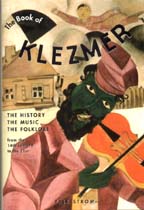 The Book of Klezmer: The History, The Music, The Folklore
The Book of Klezmer: The History, The Music, The Folklore
by Yale Strom.
Chicago, IL: A Cappella Books, 2002.
xvi, 381 p. [24] p. of plates: ill., music ; 24 cm.
ISBN: 1556524455 (hardback : alk. paper)
Bibliography: 363-369.
Discography: 371-374.
Index.
Yale Strom has written a book with enormous effort that supplies the reader with good access to extensive quotations by klezmer musicians, translations of previous scholarly works into English, 3 superb appendices, a bibliography, a very nice discography and an index. The purpose of the book is to give an overall history of klezmer music, with its growth in Eastern Europe and a look at the current scene and it's meaning today.
Strom spent several years researching the material, conducting interviews of klezmer musicians in America and Europe, and having materials translated into English. Over a twenty-year period, he made some fifty trips to Eastern Europe doing ethnographic research. Details supplied by photographic plates and the extensive quotations from his interviews abound in the book.
A highlight of special note in this book is Appendix 1, "Klezmer Zikhroynes in di Yizker Bikher," (Klezmer remembrances in the Memorial Books). This refers to the many 'yizkor' books, (Yiddish: yizker bikher) the memorial books, made by survivors of the Holocaust remembering the people and Jewish culture of their hometowns. A complete collection of these books, he states, is located at Hebrew University in Jerusalem, with many at YIVO in New York. Other major libraries, including Brandeis University Libraries, also contain numerous yizkor books.
Strom has picked out many sections from these books referring to musicians, music, weddings and other simchas involving music, and translated (or had translated) those sections from the yizkor books into English. This appendix is arranged in alphabetical order by the name of the town, and is quite useful for those seeking any information about that community. Strom also includes notes about the spellings of names, and details of how he translated numerous Yiddish words for these yizkor book entries. He states that "The bibliographic form follows the one compiled by Zachary M. Baker used today for reference at YIVO." This format will aid enormously in the usefulness of these listings, being based on the work of one of our nation's outstanding Judaica librarians.
The other two useful appendices are the "klezmer loshn"--the vocabulary or jargon of working klezmer musicians in Eastern Europe in Yiddish. It was interesting to note that some of the first examples of this Strom used to express the connotations of this jargon, was a bawdy reference to women and criminal's language, giving the feel of the "low-class" nature of the klezmer. Strom constructed the vocabulary using seven previously published works, and putting everything together in one list. However, he notes that by the time he did his research into klezmer jargon, most of the vocabulary had been forgotten. Apparently it disappeared along with the klezmorim in Europe, and doesn't seem to be part of the current klezmer world in contemporary America.
A real treat of the book is the third appendix, which are several scores of songs Strom includes from his vast repertoire learned in Eastern Europe. Some people may wind up buying the book for these 11 songs alone.
Also included is a brief discography and a glossary. The glossary is important because Strom insisted on using a Yiddish spelling for vocabulary words, even if some of those words have already had 'standardized' English spelling which are more familiar to American readers. Examples of this are: "toyre" instead of "Torah" for the scroll of the Five Books of Moses, or "bar mitsve" instead of the more standard "bar mitzvah." These changes are intended to give the reader a "Yiddish" instead of a "Hebrew" orientation to the vocabulary, lending to the "atmosphere" while reading the book. Some readers may find this annoying at first, but in general, it works overall to be consistent.
Those reading the summary of Jewish music history in chapter one, "fun David Ha-melekh biz Duvid der klezmer," need to be careful. One may use this as a starting point, but serious study of this period should rely on other scholars for details, due to some serious errors in the musicology of this chapter. Mr. Strom makes sweeping statements that often fit into a good story line, but aren't really accurate history as currently understood by most Jewish musicologists. In general, when reading the first two chapters, a reader should feel secure when reading items that are translations or quotes from previous research, but keep a questioning mind when reading summary statements of Mr. Strom.
An example of this is on p. 9, in discussing Rossi's music, he states: "Rossi and his fellow Jewish composers...they may have helped usher in a process of assimilation that sacred Jewish music underwent in Europe, a process that ended only in the nineteenth century." At first I thought there was an error in the print, but there it was. Why had this process "ended in nineteenth century," the beginning of the Reform music in Europe? That seemed quite a mistake to me. Of course, he uses the word "may", but still gives the impression musical assimilation ended in the nineteenth century. Even if Rossi's music had some lasting impact in Italy and surrounding areas, where was the influence in Eastern Europe, in the Pale of Settlement in the 17th or 18th century? Or for that matter in France or Germany? Even considering that cantorial music often adapted shades of European classical music in the 18th century, polyphonic music was not extent in those synagogues. Did he mean that it was 'OK for Jewish synagogue music to adapt ideas' from surrounding culture? If so, why does he state that the process ended in the nineteenth century? No matter how one dices up the statement, it just doesn't make sense and amounts to misinformation. Unfortunately, there are many such summary or sweeping statements throughout this book, and Mr. Strom's understanding of the forces shaping Jewish history in Eastern Europe may deserve some revisions as well.
However, that said, a person unfamiliar with any Jewish music history can still learn a lot and get a general gist of the history of Jewish music from this book. Mr. Strom is an excellent storyteller and so the reading is fun, easy and it's a quick read. (if you can just get yourself to gloss over some of the more glaring problems.) Mr. Strom appears to be a good ethnographer, and if the reader focuses only on his original field work, there is much to celebrate.
Chapters 3 and 4 of Strom's Klezmer are much stronger portions of the book. Here he gets into more familiar territory and his work benefits from the numerous primary sources he was able to garner. People may differ over some particulars of klezmer history here, but it is a much stronger and thorough examination than some previous memoirs released. Strom's discussions are strengthened by allowing the musicians to speak in their own voice. He also bravely covers an important aspect of today's klezmer music (also discussed in a recent book: Virtually Jewish : reinventing Jewish culture in Europe by Ruth Gruber)-- that is-- the phenomenon of Jewish culture being lauded and growing in European lands that participated in the Holocaust and now feel the cultural gap of not having many Jews living there. The question why klezmer music is so popular in Germany is compelling. This is an important and interesting aspect of the book, and Strom is to be applauded for eliciting such poignant statements from many practicing musicians.
The Book of Klezmer: The History, The Music, The Folklore is a mixed resource. It's greatest strengths are the gathering in of so much information on primary sources in one place, and the extensive quotations and translations of older research into English. It's weaknesses are in those areas that cover the era prior to the end of the nineteenth century. While Strom takes upon himself the enormous task of trying to summarize so much Jewish musical history, he is better suited to the modern era and the primary fieldwork he conducted. The book is worth reading for it's later sections, and we will look to another musicologist to come and fill in the gaps of the earlier history.
Load date 11.17.02
*****************************************
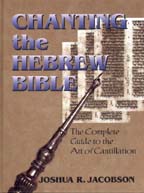 Chanting the Hebrew Bible: The Complete Guide to the Art of Cantillation
Chanting the Hebrew Bible: The Complete Guide to the Art of Cantillation
by Joshua R. Jacobson
Philadelphia: The Jewish Publication Society, 2002.
pp. 965. ill. music ; 29 cm.
bibliography pp. 937-948.
index to recording examples. + 1 companion CD (4 3/4 in.)
Precision. Thoroughness. Clarity. Devotion to Torah.
These are some of the thoughts that define my reaction to this new and excellent work by Joshua Jacobson, Professor of Music at Northeastern University in Boston, and Hebrew College in Newton, Massachusetts. This large guide may additionally properly be called a "handbook", a "textbook" or a "teacher's manual " in the pursuit of learning to chant the Jewish holy texts with understanding and correctness. Accompanying the book is a CD with demonstrations of the te'amim chanted-- featuring the pleasant voice of the author. An index to the sung examples is included in an appendix at the back of the book. This work can be used as a teaching tool or resource for professional or lay cantors, and other teachers of synagogue chant. Synagogue libraries will want to have a copy in their reference collection. Chanting the Hebrew Bible may serve as text in a serious adult education class devoted to learning Torah chant, a "leyenen" in shul course. While not recommended as something to hand to a 12-year old preparing for Bar or Bat Mitvah, it may serve as a post-Bar/Bat Mitzvah 'life-time-reference-book' gift, or to encourage bright students in furthering their learning through the high school and college years.
The outstanding features of this work are many. It is constructed in seven main parts, including: Part 1, an introduction to the ritual art and terminology; Part 2, the "sense" of cantillation, or rather how the cantillation make sense of text; Part 3, a pronunciation guide; Part 4, a history on the masoretic accents; Part 5, a "reference" section laying out the te'amim and the parsing of Hebrew sentences; and Part 6, the melodies of cantillation for Torah, Haftorah (prophets), five megilot (scrolls) and the high holidays. Part 7 are the appendices.
Precision. It becomes clear from the outset that this teacher, Jacobson, cares deeply about people "doing it right," that is, learning to chant the Bible correctly and with understanding, from the Jewish perspective. He prepares clear arguments why understanding the grammar is crucial to the practice of chanting. These systematic explanations provide the reader both with historical as well as grammatical background.
Jacobson takes the reader through the steps of learning the importance and details of grammar in a clear, understandable, step-by-step fashion. His use of distinctly styled diagrams are easy to understand. Any novice learning this material for the first time can follow the process by carefully reading the text. (A prior reading knowledge of Hebrew is required to use this book.) At each point, Jacobson includes clear examples which are very neatly laid out, and exercises to practice. Each section is built upon the knowledge of the previous section. The book must be learned in sequence to take best advantage of one of its greatest strengths.
Thoroughness. Jacobson takes the student through a careful examination of the grammar, teaching the masoretic accents, their meanings and relationships. The masoretic system includes the Hebrew consonant modifiers, or nekudot,(the "vowels" children learn in Hebrew school), and the inflection neumes or te'amim. The chapters guide the reader through the more complex combinations of the grammatical structure and deeper into the details of sentence construction - all of this kept organized through concise graphical representations.
Part 3 brings the reader into the complex world of Hebrew pronunciation. Part 4 is an interlude called "The Masorah." Here Jacobson provides historical background about the known scholarship of the origins of the te'amim, which are then produced in Part 5, called "Reference." Presented are useful charts of the te'amim, their names, meanings of names, placement, symbols, and examples. He also provides a useful transliteration chart of the Hebrew alphabet, and an interesting table he calls the "frequency chart," or a summation of the frequency of the occurrence of each of te'amim in the 21 books of the Bible, according to a popular concordance. (For example, tippekha occurs 35,980 times, but zakef gadol occus only 1,655 times).
Clarity. In section 5.4 the book reviews and systematically provides, the steps to parse the Hebrew sentence, and thus apply the te'amim properly. This will be some of the most difficult work for many people under age 45, and younger students in particular. Thirty and forty years ago, most American students were frequently required to learn to "diagram sentences" in English grammar classes, and they could apply that knowledge to learning other languages. Today the practice of teaching diagramming is very rare, so very often the process involved is unknown to today's students. For this reason, I assume that learning to understand structural relationships in Hebrew sentences with an altogether different syntax system than English will seem quite foreign and difficult. Yet, this teacher understands that each point of grammar must be brought along and taught in very small steps, and that is the process used to great effect.
Devotion to Torah. Finally in Part 6, "The Melodies of Cantillation," the student is completely prepared to attach the musical portion to her/his reading. One of the author's main points (and firm committments), is that the "music serves the text." Here, this has been ensured by teaching the grammar first. In Jacobson's pedagogy, the music becomes the overlay.
The author readily admits that traditions vary by geography, by group tradition, or even across town in different synagogues. "The multiplicity of oral musical traditions for the te'amim is a blessing, one to be cultivated rather than eliminated," he assures us. He also recognizes that in his book, "one man's melodies have been frozen in time." In a footnote to that statement, he comments that he had also notated as "alternatives" common variants within the same or similar musical communities. One small complaint of this reviewer is the wish that the origins and sources of those "alternatives" had been footnoted as well.
Jacobson's layout includes musical notation to give the tones of the te'amim while reminding the reader that any key can be used while singing. Juxtaposed with the musical staves are shaded blocks that show the placement of text along with the stressed syllables and how those coincide with the notes. Alongside the corresponding Hebrew text examples are a system of blocks which represent the syllables of the words. The stressed syllable is represented by a darkened box. This makes it crystal clear to the reader where one may precisely place the accent while singing the te'amim and applying them to texts. While Jacobson does discuss improvisation of a skilled ba'al keri'ah (master of the reading, or the Torah reader) , the thrust of his appeal is for the learner to strive for that perfection of 'exactness' and precision.
A wonderful synopsis of the history and customs of Torah reading precedes the nitty-gritty of applying all the steps together to actually start chanting Torah and Haftorah (texts from the prophets) verses. The final sections of the book consist of teaching all the variations necessary for different festive megillot of the Bible. The last chapter is devoted for the special readings on the High Holiday (Rosh Hashanah and Yom Kippur) Torah readings in morning services.
Jacobson concludes the book with an extensive glossary, bibliography and supplementary exercises for further practice, which are all quite useful at any point in the learning process.
Comparison to Other Pedagogy. Jacobson's approach to teaching Torah chanting skills may not be for everyone, but anyone learning or teaching the Jewish Hebrew Bible can benefit from this book as a background resource. In chapter 5.5, he lays out his suggested method for teaching the te'amim. He states "As in all curricula, the depth and method of study should be commensurate with the age, background, and ability of the students." He gives his suggestions on teaching a Bar/Bat Mitzvah with flash cards, dictation exercises and listening activities. He also gives suggestions to those who may be studying without the help of a skilled teacher. As with any course of music, the subject is best learned with a qualified teacher. However, this work will aid many in the years to come, to improve their skills as teachers, or to provide students with a way to master in-depth the intricacies and fascinating details required to be a ba'al keri'ah.
For those for whom leyenen Toyre is a joy, this is your new desk reference.
Reviewed 28 Tishrei 5763. October 4, 2002.
*****************************************
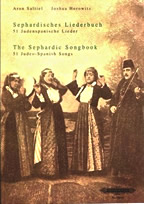 Sephardisches Liederbuch (The Sephardic Songbook): 51 Judenspanische Lieder (51 Judeo-Spanish Songs)
Sephardisches Liederbuch (The Sephardic Songbook): 51 Judenspanische Lieder (51 Judeo-Spanish Songs)
Collected and edited by Aron Saltiel With Transcriptions and an introduction by Joshua Horowitz
Frankfurt: Edition Peters, 2001. Nr. 10849
The Sephardic Songbook is an academic work, based on original fieldwork taken between 1976 and 1996 in Bat-Yam, Sarajevo, Thessaloniki, and Istanbul among other places. The transcriptions are based on vocal traditions taken from informants, usually performed without any accompaniment. The book attempts to "be true to" the performance style of the informants. Standard notation is used. Harmonies are not provided in order to preserve the "modal character of most of the songs".
An extensive and detailed introduction discusses the difficult issues surround vocal style, modal performance practicies, tempi, meter and rhythm, vocal ornamentation, microtonality and other factors affecting the true nature of the works.
The Songbook is completely bilingual in German and English, providing translations into both German and English for each song, as well as the text of the Introduction and the 'Annotations' description section at the back of the book. There are brief biographical sketches provided about the informants as well Saltiel and Horowitz.
jp 03.04.02
*****************************************
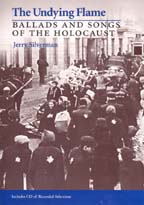 The Undying Flame: Ballads and Songs of the Holocaust
The Undying Flame: Ballads and Songs of the Holocaust
by Jerry Silverman
Syracuse University Press, 2002. 305pp. ill. CD.
Introduction on pp. xv-xxix.
Subtitle reads: "110 Songs in 16 Languages with Extensive Historical Notes, Illustrations, Piano Arrangements, Guitar Chords and Singable English translations. Includes a CD of 14 Songs".
The songs are in "Yiddish, German, Hebrew, Spanish, French, Dutch, Italian, Serbo-Croatian, Ladino, Greek, Norwegian, Czech, Polish, Russian, Hungarian and English." Texts appear in each language's transliteration and English translations. An introduction to each song is given. Often there are illlustrations or other documentation that accompany a song. Histories of the songs are given if known. Authors of texts and composers are attributed when known.
An announcement about this book on HaSafran from Aviva Astrinsky states that this is "a major collection of Holocaust music. Most of the songs have never appeared in print before. Over 300 pages.The book is divided into three main sections:
- The Gathering Storm: 1933-1939
- Shoah: 1940 - 1945
- Kaddish: A Post-War Retrospective
jp 03.04.02
*****************************************
 Mordechai Gebirtig: His Poetic and Musical Legacy
Mordechai Gebirtig: His Poetic and Musical Legacy
Edited by Gertrude Schneider
Westport, Conn.: Praeger, 2000.
Prologue 1-6. pp. 209. bibl. index.
Scores. Texts in Yiddish language, transliteration and English translations.
A biography by Sara Rosen about Gebirtig (17-38) gives a very good picture of the life of the composer. Included in the book are songs with score, and poems and songs with only the texts surviving. Also included in the introductory section are pieces that the editor speculates are written by Gerbirtig.
Mordechai Gebirtig was a folk composer of Yiddish song who lived in and around Crakow, Poland, and died during the Holocaust. He was a poor carpenter who was self-taught in music and composed songs completely by ear, remembering them all in his head. Because he was illiterate in music, friends notated his songs. Despite the handicaps, Gebirtig's (also spelled Gebertig) songs grew wildly popular and were picked up, even in the United States, to become part of folk, popular theater and sheet music repertoire. Several books of his music were published during his lifetime. This volume attempts to bring the body of his work together in one place, and to include as many previously unpublished items as possible. Many of the printed scores appear to be taken directly from the original proofs of his earlier publications --as the printing, fonts and score are identical to Gebirtig's own publications from Mayne Lider.
Sara Rosen's wonderful biography includes ample mention of sources for those who had first hand knowledge about Gebirtig.
Gertrude Schneider's moving Prologue to the volume gives the outlines of her interaction early in her life with his work.
jp 03.04.02
*****************************************
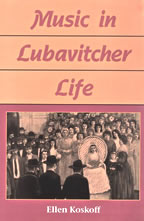 Koskoff, Ellen, 1943-
Koskoff, Ellen, 1943-
Music in Lubavitcher life
Urbana : University of Illinois Press, c2001.
Did you every want to know what all the da di di di da and bam bam bam were
really all about in the nigunim of Lubavitcher Hasidim? Do you know how the music reflects their philosophy of the two souls?
Let me recommend "Music in Lubavitcher Life" by Ellen Koskoff. I can tell you it's something that it will fascinate a lot of people.
There are so many questions about Hasidism and their music that are answered by this book. It's insightful and full of information presented in a very
clear, understandable and readable way. While the book is academic, with plenty of research and bibliography, it's still quite easy to read. And
there are lots of specific musical examples and explanations. Ellen has done original ethnographic fieldwork among the community as she's been interested in the music and working in the Chasidic community for over 25 years.
Ellen Koskoff has written many articles on ethnomusicology. In 2000, I heard her give a most interesting lecture at the London conference about the role of women in music in the religious communities. This new book takes more of an overview discussing all sorts of aspects of music in the Lubavitcher life.
jsp/January 22, 2002.